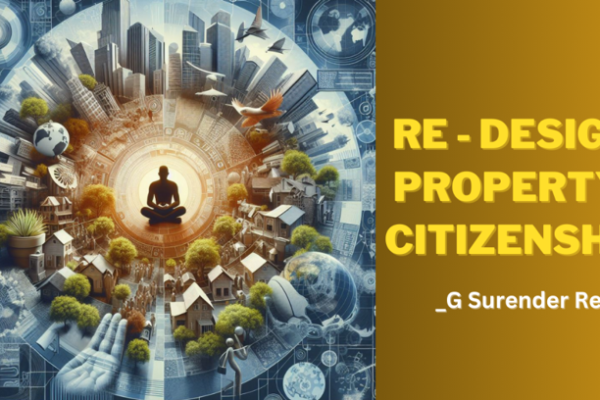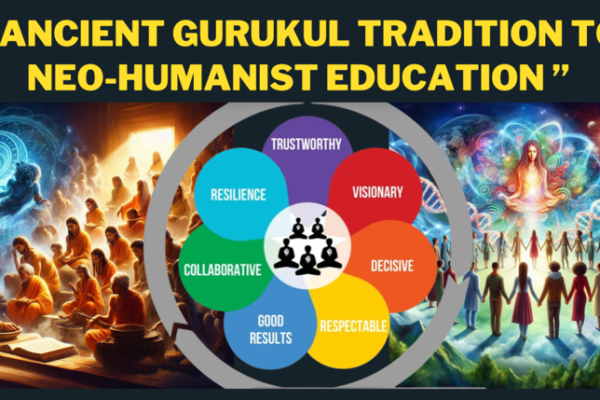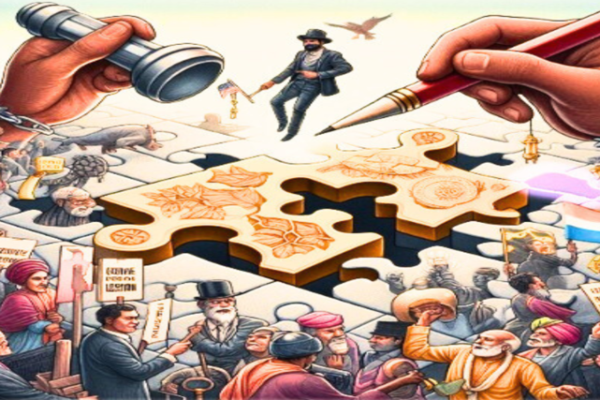– Dr. Hans-Joachim Rudolph, MRI
A few days ago, three of us sat together and talked about various kinds of things. Suddenly Caetanya picked up my new book (Microvita: Essays 2017-2023) and said that Prabhat Ranjan Sarkar’s ‘Four-Chamber-Model’ is actually quite incomprehensible. It should be possible to explain it in a way that even a 12-year-old can understand.
Admittedly, it is difficult to explain in simple words. This is because it is not about things, but about a background that is common to all objects (and subjects). You can compare it to a fish that does not realize that it is swimming in water; or to our ancestors, who understood the air as something empty; or to our contemporaries, who take it for granted that we are in space.
Mathematical versus discursive approach
We mentioned that the four-chamber model can be explained quite easily in mathematical terms – provided that you have made yourself familiar with the mathematical language. It becomes difficult when you have to translate this concept into simple words. So, as I said, it’s not about things, but about their basic premises. That’s why I’m going to try a comparison with the subjunctive and indicative of our common languages, i.e. with the space of possibilities and the space of actualities – whereby the latter can only refer to the past and present, whereas the possibilities are predominantly located in the wide fields of future. Of course, we can also speculate about what would have happened if this or that would have happened at some point in history, but such games of thought usually lead nowhere.
Scientific perspective and new approaches
The next step was to take a scientific approach, which is primarily concerned with the question of how existing matter and energy can best be manipulated. Gotthard Günther, however, had suggested that a new science would have to deal with space and the possibilities of manipulating it. This approach would then open up space for completely new approaches and questions that go beyond traditional understanding.
Mathematical concepts and their connection to the four-chamber model
The further discussion focused on certain mathematical concepts and their applicability to the four-chamber model. The starting point was Euclidean space and the Cartesian coordinate system. The complex numbers were then introduced, which were already known to René Descartes, but whose significance was only understood by Carl Friedrich Gauss. A scene from the movie “Measuring the World” was used to illustrate the power of this idea and its relevance for understanding the four-chamber model.
Another interesting observation resulted from the permanent change between perception and imagination, as can be seen in our own eye movements. This allows the introduction of a complex understanding of space, which, as the name suggests, must include a real and an imaginary compartment. With the help of this concept, the complexity of our consciousness and its connections to mathematical and philosophical ideas could be clarified.
Extension to cosmic consciousness
Our discussion about the interplay between real and imaginary space led to the consideration that this scheme should be extended to cosmic consciousness. This brought us to panpsychism, which assumes that the entire universe is permeated by a kind of consciousness. We were thus able to widen our understanding of the four-chamber model and show that it not only refers to states of individual consciousness, but can be widened to cosmic dimensions.
The need for an inner observer
The discussion then turned to the necessity of an inner observer and thus to additional, subjective spaces. It became clear that the four-chamber model not only encompasses real and imaginary space, but that further subjective dimensions must be taken into account, which increases the complexity of consciousness as well as the multiplicity of its possibilities.
Quote from Einstein and the inclusion of Indian philosophy
Based on a quote from Albert Einstein, it was then pointed out that things should be made as simple as possible, but not even simpler. Applied to the four-chamber model, this means that a two-chamber model would be inadequate and could not meet the required balance between simplicity and completeness. Therefore, concepts of Indian philosophy, which describe subjectivity as Mahat and Aham or Jina Purusha and Krta Purusha, were associated with the four-chamber model. These philosophical concepts enrich the model and show the variety of perspectives that need to be included in its interpretation.
Influence of philosophical and spiritual teachings on the model
The discussion then expanded to include the influence of Western philosophers such as Martin Heidegger and Graham Harman. It was discussed how these thinkers interpreted their ‘Fourfolds’ and what meaning they attached to them. In addition, spiritual concepts such as the doctrine of Angels, the Jinn and the Deva and Pretayonis (with Yonis as the potential openings to other spacetimes) were considered. The extension of the model to include metaphysical and spiritual aspects illustrates its applicability beyond purely scientific boundaries.
Applications and practical implications
Another aspect of the discussion was the application of the four-chamber model to areas of quantum mechanics, electronics, computer science, robotics and artificial intelligence. This made it clear that the understanding of the four chambers is not only theoretically interesting, but can also have practical implications. Finally, we talked about the quaternions, which make it possible to mathematize the four-chamber model. It was pointed out that calculating with quaternions was made possible only by an epiphany that happened to Sir William Rowan Hamilton in Dublin while crossing a bridge.
“Renaissance 3.0” and the mathematization of the world
As the hour progressed, the discussion turned to the “Renaissance 3.0” exhibition conceptualized by Peter Weibel (https://zkm.de/de/ausstellung/2023/03/renaissance-30), in which current developments in high technology were compared with their predecessors in Baghdad and Florence.
It was emphasized that the mathematization of the world made its way into the arts since long and that this development has a long-standing history. Thus, “Renaissance 3.0” symbolizes a new era of technological and creative development in which mathematics plays a central role, similar to earlier periods of cultural renewal.
Intermal infinity and the difference to AI
Finally we considered the infinity inherent in each human being. Comparable to Achilles’ race with the tortoise, we can never reach the core of our self. Although we can objectify parts of our being and even translate them into computer programs in order to develop artificial intelligence, the complete capture of our being remains impossible in principle. This demonstrates that our decisive advantage over machines lies in our introversion: as humans, we are able to constantly reflect on ourselves and explore an inner depth that machines can never achieve. This difference has been emphasized as the main reason for our fundamental superiority over artificial intelligence.





